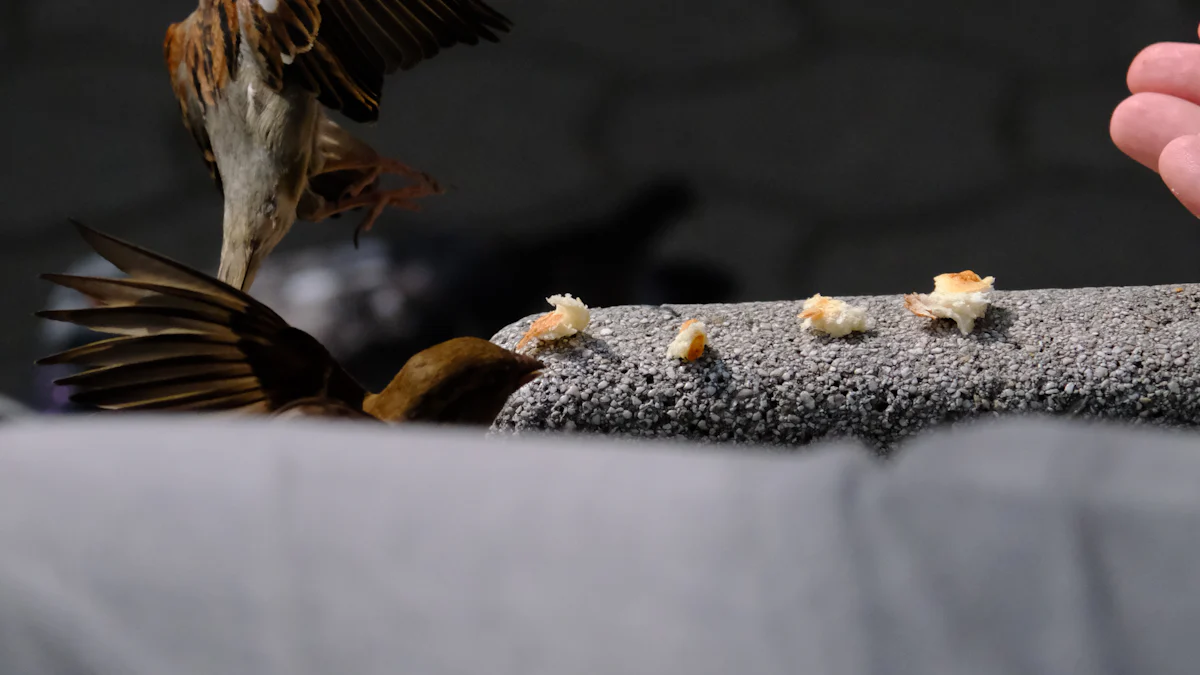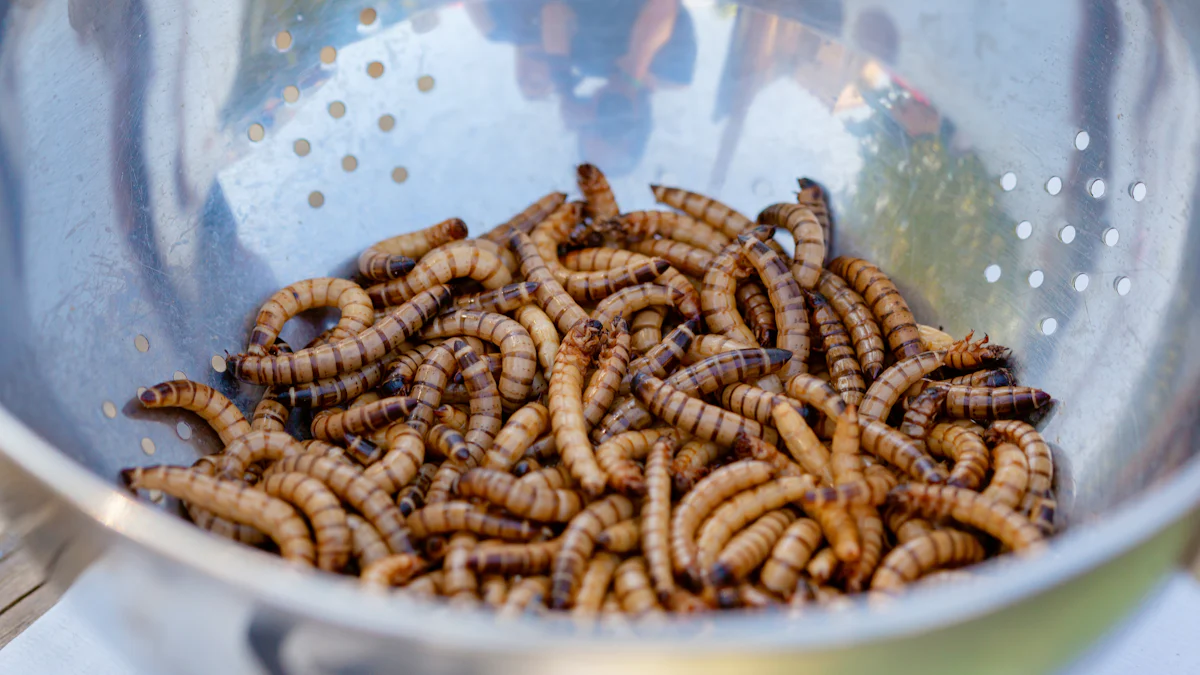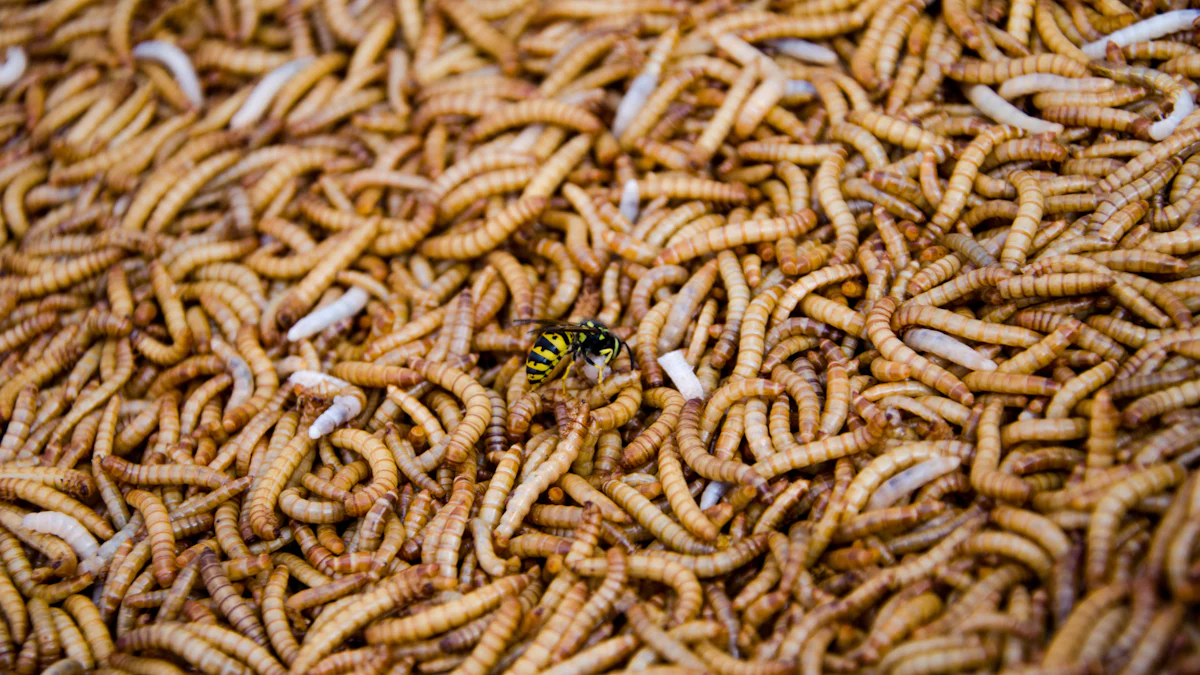
Dried mealworms for birds offer a powerhouse of nutrition. They provide essential proteins, fats, vitamins, and minerals crucial for your feathered friends’ growth and health. With a protein content of around 50%, these mealworms support muscle development and feather growth. You’ll find that dried mealworms attract a variety of bird species, from bluebirds to cardinals, enhancing your backyard birdwatching experience. Choosing high-quality mealworms ensures your birds receive top-notch nutrition, boosting their energy levels, especially during migration or breeding seasons. Opt for premium options to keep your birds healthy and active.
Key Takeaways
- Dried mealworms are a rich source of protein (around 50%), essential for birds’ muscle development and feather growth.
- Choose high-quality, organic, or non-GMO mealworms to ensure your birds receive the best nutrition and avoid harmful substances.
- Consider ethical sourcing practices when selecting mealworms to support sustainable and responsible pet food production.
- Store dried mealworms in a cool, dry place to maintain their freshness and nutritional value; resealable packaging can enhance convenience.
- Introduce mealworms gradually to your birds and mix them with other foods for a balanced diet that attracts a variety of species.
- Adjust the quantity of mealworms based on seasonal bird activity to prevent waste and ensure your feathered friends are well-fed.
- Explore popular brands like Kaytee, Pennington, and TradeKing to find the best dried mealworms that suit your needs and budget.
Criteria for Selecting the Best Dried Mealworms for Birds
When choosing dried mealworms for birds, you want to ensure you’re providing the best nutrition and quality. Let’s dive into the key criteria to consider.
Nutritional Value
Protein Content
Dried mealworms are a powerhouse of protein, which is essential for your birds’ muscle development and overall health. With a protein content of around 50%, they offer a robust source of energy. This high protein level supports feather growth and helps birds during breeding seasons. When selecting mealworms, check the packaging for protein content to ensure your feathered friends get the best.
Essential Vitamins and Minerals
Besides protein, dried mealworms for birds are rich in essential vitamins and minerals. These nutrients play a crucial role in maintaining your birds’ health. Look for mealworms that are raised on a nutrient-rich diet. This ensures they are packed with the vitamins and minerals your birds need to thrive.
Sourcing and Quality
Organic vs. Non-Organic Options
You might wonder whether to choose organic or non-organic mealworms. Organic mealworms are raised without synthetic pesticides or fertilizers, making them a safer choice for your birds. Non-GMO options are also available, ensuring the mealworms are free from genetically modified ingredients. Opting for organic or non-GMO mealworms can enhance their nutritional value and provide a healthier diet for your birds.
Ethical Sourcing Practices
Ethical sourcing is another important factor. Choose mealworms from reputable suppliers who follow sustainable and ethical practices. This ensures the mealworms are free from harmful substances like pesticides and preservatives. By supporting ethical sourcing, you contribute to sustainable practices in the pet food industry.
Packaging and Storage
Shelf Life Considerations
One of the advantages of dried mealworms is their long shelf life. They don’t require refrigeration, making them convenient to store. When purchasing, check the expiration date to ensure freshness. Proper storage will keep them nutritious and safe for your birds.
Ease of Storage
Dried mealworms are less messy than live ones and easy to handle. Store them in a cool, dry place to maintain their quality. Some brands offer resealable packaging, which helps keep the mealworms fresh and makes storage even more convenient.
By considering these criteria, you can select the best dried mealworms for your birds, ensuring they receive top-notch nutrition and care.
Customer Reviews and Testimonials on Dried Mealworms for Birds
When it comes to choosing the best dried mealworms for birds, hearing from other bird enthusiasts can be incredibly helpful. Let’s explore what customers have to say about their experiences.
Positive Feedback
Success Stories from Bird Owners
Many bird owners rave about the impact dried mealworms have on their feathered friends. One user shared how their backyard transformed into a lively bird sanctuary after introducing dried mealworms. Bluebirds, cardinals, and even some unexpected visitors started frequenting their feeders. The mealworms’ high protein content and nutritional value seem to play a significant role in attracting such a diverse array of species.
“Flock Fest mealworms brought a variety of birds to my yard, including bluebirds and cardinals. My birds are more active and healthy,” one satisfied customer noted.
Commonly Praised Features
Customers often highlight the freshness and quality of the mealworms. Brands like Flock Fest and Royal Wing receive praise for maintaining high standards. Users appreciate the convenience of resealable packaging, which keeps the mealworms fresh for longer periods. The affordability of some brands also stands out, making it easier for bird lovers to provide nutritious treats without breaking the bank.
Constructive Criticism
Areas for Improvement
While many reviews are positive, some users point out areas for improvement. A few customers mention that certain brands could enhance the consistency of their product sizes. Birds might prefer uniform mealworms, making it easier for them to consume.
Common Complaints
Some common complaints revolve around the occasional presence of broken mealworms in the packaging. Although this doesn’t affect the nutritional value, it can be less appealing visually. A few users also suggest clearer labeling regarding the organic or non-GMO status of the mealworms, helping them make informed choices.
Overall, customer reviews provide valuable insights into the performance of different brands. By considering both positive feedback and constructive criticism, you can make an informed decision when selecting dried mealworms for your birds.
Comparison of Popular Brands and Products of Dried Mealworms for Birds

When you’re on the hunt for the best dried mealworms for birds, it’s essential to compare popular brands. Let’s dive into what makes each brand unique and what you should consider.
Kaytee
Kaytee is a well-known name in the bird food industry. Their dried mealworms stand out for several reasons.
Pros
- Consistent Quality: Kaytee mealworms maintain a high standard of quality. You can trust that each batch will meet your expectations.
- Attracts Various Bird Species: Many bird enthusiasts report that Kaytee mealworms attract a wide range of birds, from bluebirds to cardinals. This makes them a versatile choice for your backyard feeders.
Cons
- Price Point: Some users find Kaytee mealworms slightly more expensive compared to other brands. However, the quality often justifies the cost.
- Packaging Size: The available packaging sizes might not suit everyone’s needs, especially if you’re looking for bulk options.
Pennington
Pennington offers a reliable option for those seeking value without compromising on quality.
Pros
- Excellent Value: Pennington mealworms provide great value for money. You get a quality product at a reasonable price.
- Freshness: Customers frequently praise the freshness of Pennington mealworms, which is crucial for maintaining nutritional value.
Cons
- Limited Availability: Depending on your location, Pennington products might not be as readily available as other brands.
- Packaging Concerns: Some users have noted that the packaging could be more durable to prevent spills.
TradeKing
TradeKing is another popular choice among bird lovers, known for its bulk options.
Pros
- Bulk Options: TradeKing offers large quantities, making it ideal for those who feed birds regularly or have multiple feeders.
- Affordable Pricing: Despite the bulk size, TradeKing mealworms are competitively priced, offering affordability for frequent feeders.
Cons
- Inconsistent Sizes: Some customers mention that the mealworms vary in size, which might not be ideal for all bird species.
- Storage Requirements: Due to the bulk nature, proper storage is necessary to maintain freshness and prevent spoilage.
Choosing the right brand of dried mealworms for birds depends on your specific needs and preferences. Whether you prioritize quality, value, or quantity, there’s a brand out there that fits your requirements.
Tips for Using Dried Mealworms for Birds Effectively

Feeding Techniques
How to Introduce Mealworms to Birds
Introducing dried mealworms to your feathered friends can be a delightful experience. Start by offering them in small quantities. You can sprinkle them on the ground or place them in a tray feeder. Birds like bluebirds, chickadees, and nuthatches will likely be the first to notice this tasty treat. If you want to make them more appealing, try soaking the mealworms in water for about 30 minutes. This makes them softer and easier for birds to eat, especially during nesting periods when hydration is crucial.
Mixing with Other Bird Foods
Dried mealworms for birds can be a fantastic addition to their diet, but they shouldn’t be the only food source. Mix them with seeds, fruits, or suet to create a balanced meal. This combination not only provides variety but also ensures that birds receive a range of nutrients. You might even try making snack balls by mixing mealworms with peanut butter and seeds. This creative approach caters to different bird species and their dietary preferences.
Seasonal Considerations
Best Times of Year to Use Mealworms
While dried mealworms are beneficial year-round, certain times of the year make them even more valuable. During the breeding season, birds need extra protein for energy and growth. Mealworms provide this essential nutrient. In winter, when natural food sources are scarce, they offer a reliable source of nutrition. Keep an eye on your local bird activity to determine the best times to offer mealworms.
Adjusting Quantities Based on Bird Activity
Bird activity can vary with the seasons, so it’s important to adjust the quantity of mealworms you provide. In spring and summer, when birds are more active, you might need to increase the amount. Conversely, during quieter months, reduce the quantity to avoid waste. Observing your backyard visitors will help you gauge the right amount to keep them satisfied and healthy.
By following these tips, you can effectively use dried mealworms to attract and nourish a variety of bird species. Whether you’re introducing them for the first time or mixing them with other foods, these techniques will enhance your birdwatching experience and support your feathered friends’ well-being.
When it comes to choosing the best dried mealworms for birds, consider top brands like Kaytee, Pennington, and TradeKing. These options offer quality, value, and variety. To maximize benefits, introduce mealworms gradually and mix them with other bird foods. This approach ensures a balanced diet and attracts diverse bird species. Share your experiences and feedback with fellow bird enthusiasts. Your insights can help others make informed choices and enhance their birdwatching adventures.
FAQ
Are dried mealworms good for birds?
Absolutely! Dried mealworms are a fantastic food source for birds. They pack a punch with their high protein and fat content, which is crucial for your feathered friends’ growth and health. With around 50% protein and 25% fat, mealworms provide the energy birds need, especially during cold weather or breeding seasons. Protein helps with muscle development and feather growth, while fat offers concentrated energy.
How do dried mealworms benefit birds?
Dried mealworms attract a wide variety of bird species due to their rich nutritional content. They offer essential proteins, fats, vitamins, and minerals that are vital for birds’ growth, health, and survival. Proper storage and preparation ensure that mealworms maintain their nutritional value, keeping your birds safe and healthy.
What is the nutritional value of dried mealworms for birds?
Dried mealworms are high in protein, which is essential for the growth, repair, and maintenance of feathers in birds. Feathers consist mainly of protein, so a lack of it can lead to dull, brittle feathers that break easily. By providing mealworms, you help ensure that your birds have the nutrients they need for vibrant, healthy plumage.
What are mealworms and how are they beneficial for birds?
Mealworms are the larval form of the mealworm beetle, Tenebrio molitor. They serve as a valuable food source for wild birds. High in protein, mealworms support muscle development and can be raised in large numbers. Birds consume mealworms as part of a balanced diet, which includes a variety of foods.
Which birds can I feed dried mealworms to?
You can feed dried mealworms to a variety of birds, including parrots, songbirds, and raptors. Each bird species may have different feeding needs. For instance, songbirds like bluebirds and chickadees enjoy mealworms as a treat, while raptors might require larger quantities. Adjust the feeding amount and frequency based on the bird species and their activity levels.
How should I feed dried mealworms to birds?
You have several options for feeding dried mealworms to birds. You can offer them directly in a tray feeder or sprinkle them on the ground. Mixing mealworms with seeds or fruits creates a balanced meal that caters to different dietary preferences. You might also try making snack balls by combining mealworms with peanut butter and seeds. This variety ensures that you meet the diverse needs of your backyard visitors.
Where can I learn more about dried mealworms for wild birds?
For more detailed information about dried mealworms for wild birds, you can visit this link. It provides insights into their benefits and how to use them effectively in bird feeding.
By understanding these aspects of dried mealworms, you can enhance your birdwatching experience and support the well-being of your feathered friends.


